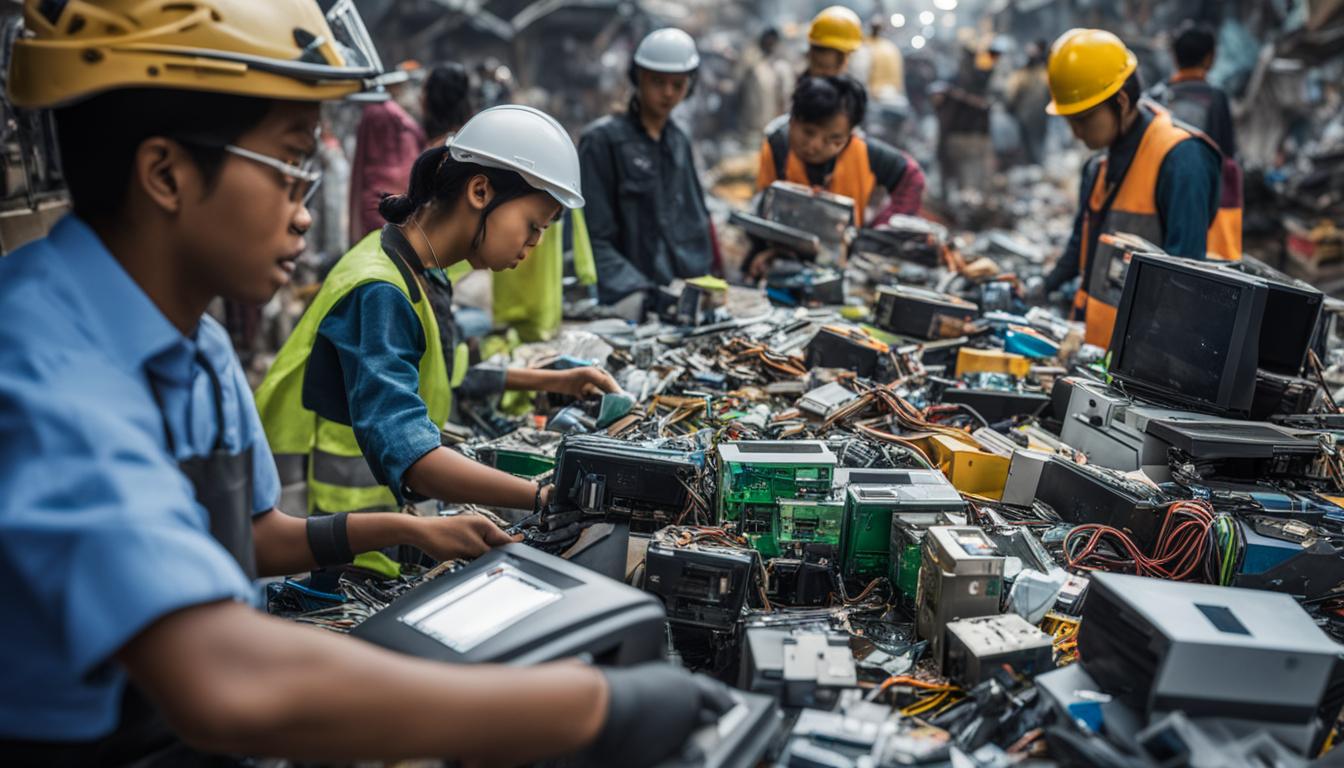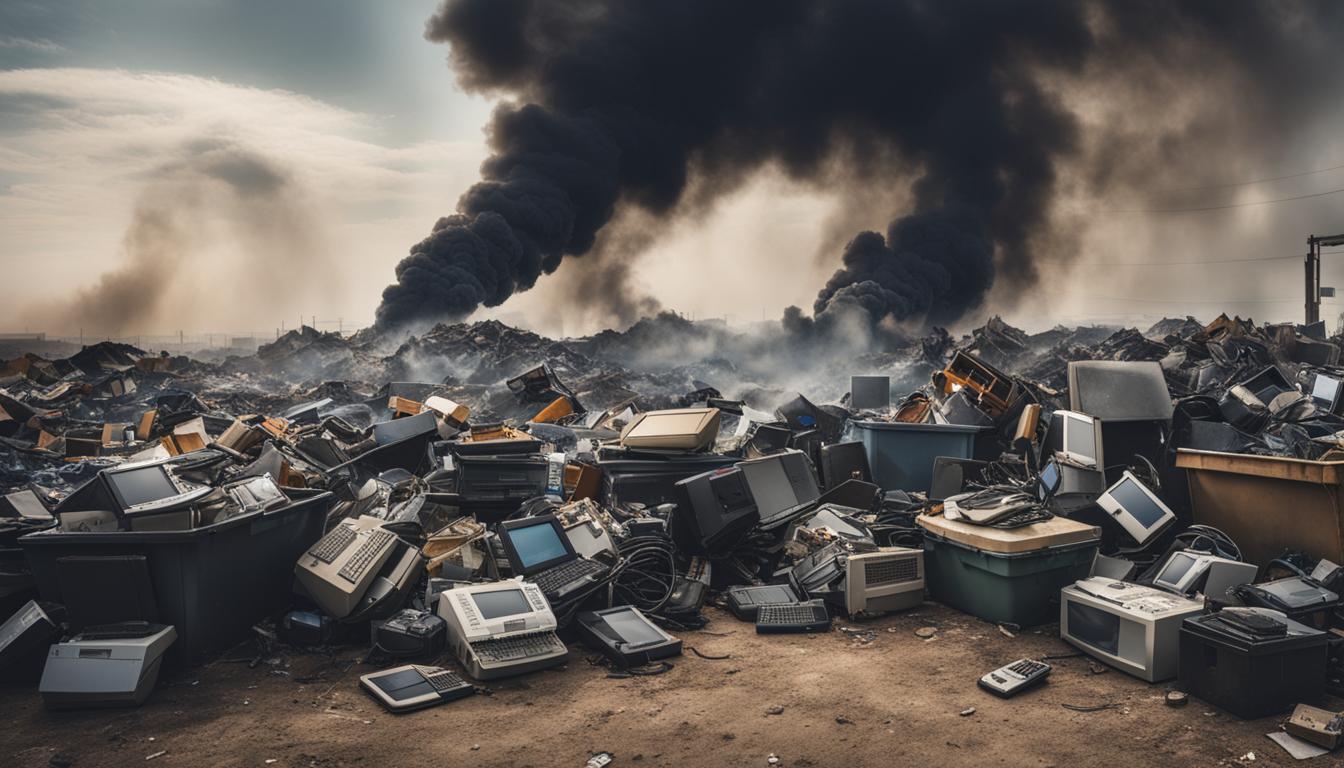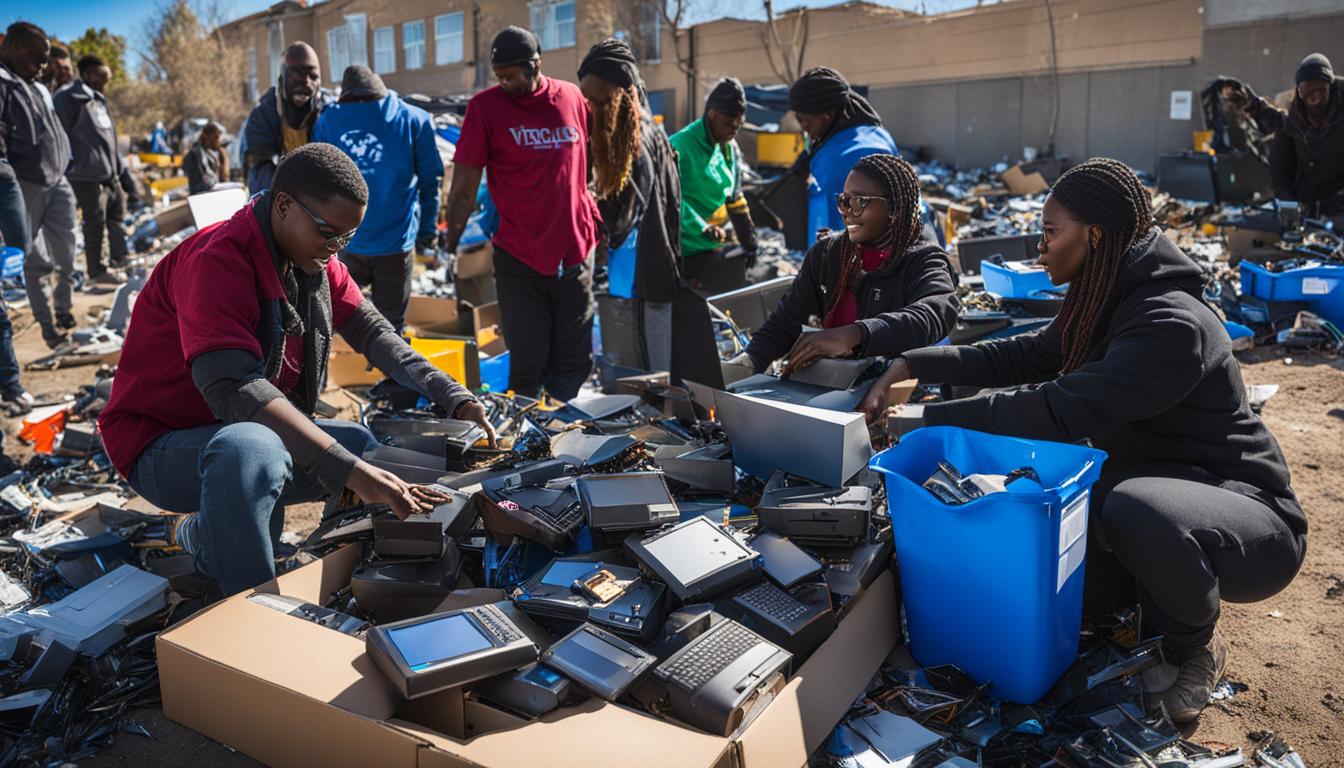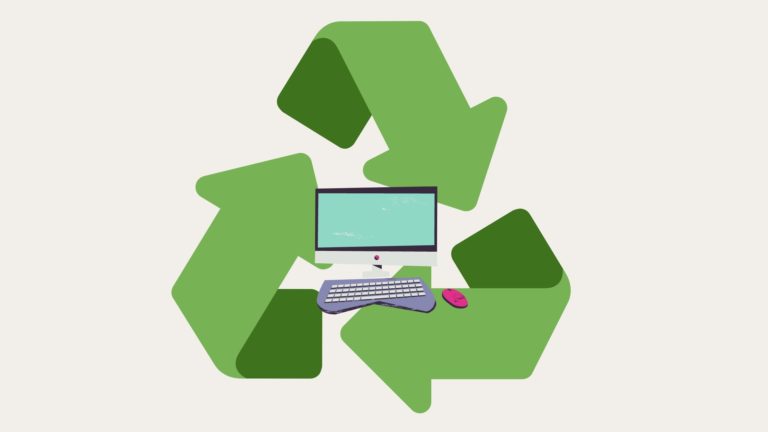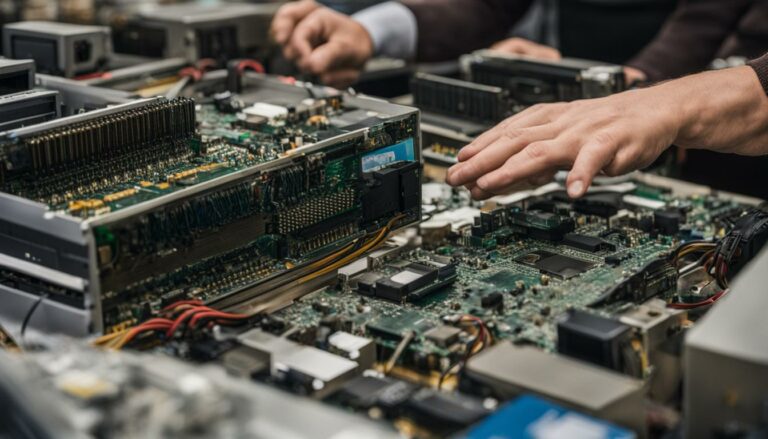Transforming E-waste into Opportunity
E-waste is a growing environmental and social concern, with the global generation expected to increase annually. Improper e-waste management leads to harmful effects on the environment, human health, and depletion of natural resources. The management of e-waste involves various stages, including collection, treatment, recycling, and disposal. Plastics and toxic elements are common components of e-waste, requiring specialised recycling technologies. Valuable metals such as gold, silver, and copper can also be found in e-waste. Proper e-waste management is essential to mitigate environmental impacts and create new opportunities for sustainable ventures.
Key Takeaways
- E-waste presents significant environmental and social challenges
- Proper management of e-waste is crucial to minimise its negative impacts
- E-waste contains valuable metals that can be recovered through recycling
- The e-waste recycling industry offers economic growth and job creation
- Collaboration, innovation, and strong policies are key to effective e-waste management
The Environmental Impacts of E-waste
Improper e-waste management has significant environmental impacts, including pollution of soil, oceans, and groundwater. Electronic waste contains toxic elements such as mercury, lead, and arsenic, which pose serious risks to human health and the environment. To mitigate these impacts, effective e-waste management practices must focus on recycling methods, reducing the generation of e-waste, and implementing proper disposal options.
Recycling e-waste is a crucial step in minimizing its environmental footprint. Through recycling, valuable materials can be recovered and reused, reducing the need for new extraction and production. This not only conserves natural resources but also helps to prevent the release of hazardous elements into the environment. Additionally, by reducing the generation of e-waste through practices such as product longevity and repairability, we can further decrease the environmental impacts associated with electronic waste.
Proper electronic waste management is essential to safeguard the environment and human well-being. By recycling e-waste and reducing its generation, we can minimize the negative environmental impacts and preserve valuable resources for future generations.
In addition to recycling, it is crucial to implement proper disposal options for e-waste. This ensures that hazardous materials are safely contained and do not leach into the environment. Governments, businesses, and individuals all play a role in creating and adhering to policies and regulations that promote responsible e-waste management. By working together, we can reduce the environmental impact of e-waste and protect our planet for generations to come.
The Environmental Impacts of E-waste: A Summary
E-waste, if improperly managed, can have severe environmental consequences. It pollutes soil, oceans, and groundwater, posing risks to human health. Recycling e-waste and reducing its generation are key strategies to minimize these impacts. By recovering valuable materials through recycling and implementing proper disposal options, we can mitigate the negative environmental effects of e-waste and preserve valuable resources for the future.
The Value of E-waste
E-waste, despite being considered a problem, actually holds significant value in terms of the materials it contains. Through appropriate recycling methods, valuable metals such as gold, silver, copper, and other precious resources can be extracted from e-waste and reused in various industries. This not only reduces the need for extracting virgin materials but also provides a sustainable solution for meeting the demand for these valuable resources.
The e-waste recycling industry plays a vital role in unlocking the value of e-waste. It not only contributes to the preservation of natural resources but also provides opportunities for economic growth and job creation. Recycling e-waste not only minimizes the environmental impact of improper disposal but also helps to foster a circular economy where waste is seen as a valuable resource. By promoting the recycling industry and implementing proper e-waste disposal options, we can harness the potential of e-waste and create a more sustainable future.
| Valuable Metals | Potential Reuse |
|---|---|
| Gold | Jewelry, electronics, medical devices |
| Silver | Electronics, photography, solar panels |
| Copper | Electrical wiring, plumbing, construction |
By recognizing and capitalizing on the value of e-waste, we can not only reduce the environmental impact of improper disposal but also create a more sustainable and efficient e-waste management system. It requires the implementation of effective e-waste recycling methods and the development of suitable infrastructure for e-waste disposal options. Through collaborative efforts between governments, businesses, and individuals, we can maximize the potential of e-waste and contribute to a more circular economy.
Challenges in E-waste Management
The management of electronic waste poses several challenges that hinder its efficient handling and recycling. These challenges arise from various factors, including inadequate infrastructure, limited awareness, weak policies, and a scarcity of sustainable recycling technologies.
One of the significant challenges in e-waste management is the lack of collection points. Many regions struggle to establish proper collection systems that can efficiently collect e-waste from households, businesses, and other sources. This results in e-waste being disposed of in general waste streams, leading to environmental contamination and the loss of valuable resources.
Another challenge is the limited awareness and environmental education surrounding e-waste. Many individuals are unaware of the harmful effects of improper e-waste disposal and the importance of recycling. Without proper education and awareness campaigns, it becomes difficult to encourage responsible e-waste management practices and promote the recycling of electronic devices.
“The improper management of e-waste contributes to pollution of soil, oceans, and groundwater, posing risks to human health and the environment,” says Dr. Emma Thompson, a renowned environmental scientist.
In addition to infrastructure and awareness challenges, weak policies and a lack of government oversight further hinder e-waste management efforts. In some regions, there is a lack of comprehensive regulations and enforcement mechanisms to ensure the proper collection, treatment, and disposal of e-waste. This creates loopholes that allow illegal dumping and improper handling of e-waste.
Furthermore, the scarcity of sustainable recycling technologies presents a significant challenge. E-waste contains complex components, including plastics and toxic elements, which require specialized recycling processes. The lack of efficient and environmentally friendly recycling technologies limits the ability to recover valuable metals and materials from e-waste, resulting in a loss of resources and contributing to environmental degradation.
The Current Challenges in E-waste Management:
- Lack of collection points for proper e-waste disposal
- Limited awareness and environmental education
- Weak policies and inadequate government oversight
- Scarcity of sustainable recycling technologies
Addressing these challenges requires collaboration between governments, businesses, and other stakeholders involved in e-waste management. By working together, it becomes possible to establish comprehensive e-waste collection systems, raise awareness about the importance of responsible disposal, enact stronger policies and regulations, and invest in research and development for sustainable recycling technologies.
| Challenges | Potential Solutions |
|---|---|
| Lack of collection points | Establishing more collection centers and implementing convenient e-waste drop-off points |
| Limited awareness and environmental education | Conducting educational campaigns to inform the public about the importance of e-waste recycling and responsible disposal |
| Weak policies and inadequate government oversight | Enacting comprehensive regulations and strengthening enforcement mechanisms to ensure proper e-waste management |
| Scarcity of sustainable recycling technologies | Investing in research and development of advanced recycling technologies to efficiently recover valuable materials from e-waste |
Innovations and Opportunities in E-waste Management
As the global generation of e-waste continues to rise, innovative solutions and opportunities are emerging in the field of e-waste management. Manufacturers are adopting eco-design and modular design principles, paving the way for more sustainable electronic products. Reverse logistics is being implemented to enable product reuse and recycling, reducing the overall volume of e-waste that ends up in landfills. Advanced technologies are also being developed to optimize the recycling of e-waste, extracting valuable metals and materials.
One significant innovation in e-waste management is the concept of the circular economy. This approach aims to keep resources in use for as long as possible, extracting maximum value from them before recovering and regenerating products and materials. By embracing the circular economy, businesses can minimize waste and create a more sustainable system for managing e-waste. Urban mining is another strategy that focuses on extracting valuable resources from e-waste, reducing the need for traditional mining operations.
“The circular economy and urban mining are transforming the way we manage e-waste, turning it into a valuable resource rather than a harmful burden.”
Advancement in Recycling Technologies
The advancement of recycling technologies is also driving innovation in e-waste management. Researchers and scientists are developing new methods to efficiently separate and recover valuable metals and materials from e-waste. These technologies include hydrometallurgical processes, biotechnological approaches, and innovative sorting techniques. By improving recycling technologies, the e-waste recycling industry can extract greater value from e-waste and reduce its environmental impact.
Additionally, collaboration between governments, businesses, and research institutions is crucial for fostering innovation and advancing e-waste management practices. By working together, stakeholders can share knowledge and resources, accelerating the development and implementation of sustainable waste management solutions.
| Advantages of Innovations in E-waste Management | Opportunities for E-waste Recycling |
|---|---|
| Reduces environmental pollution | Creating new jobs in the e-waste recycling industry |
| Maximizes resource recovery | Promoting the growth of the circular economy |
| Minimizes the need for traditional mining | Unlocking the value of e-waste through efficient recycling |
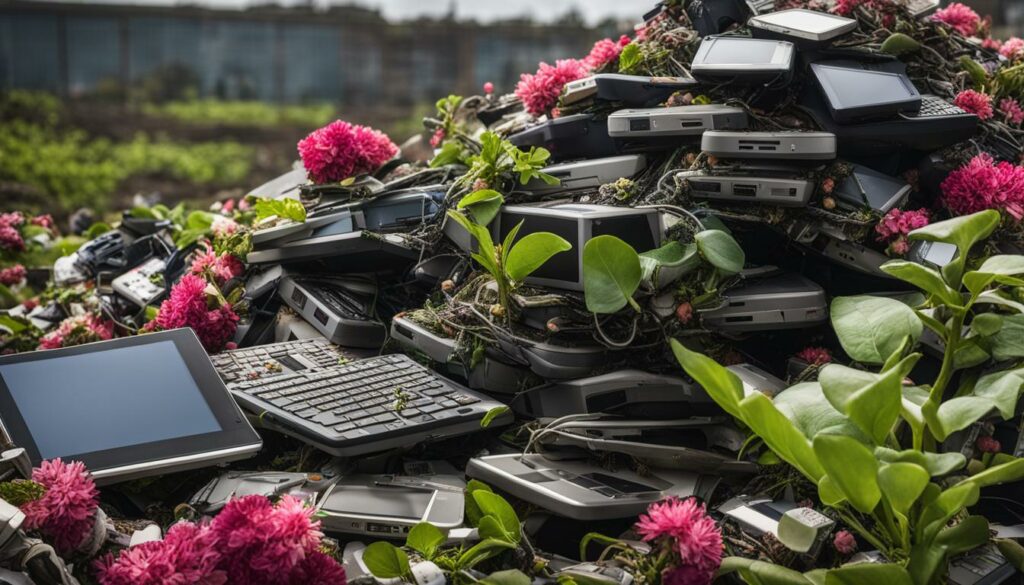
By embracing these innovations and opportunities, the e-waste management sector can move towards a more sustainable and efficient future. With the proper implementation of waste management solutions and the adoption of advanced e-waste recycling methods, we can transform e-waste from a challenging problem into a valuable resource.
Global Efforts and Policies in E-waste Management
Governments and international organizations are taking significant steps to address the challenges of electronic waste management and implement effective policies on a global scale. With the increasing awareness of the environmental and health risks associated with improper e-waste disposal, countries and economic blocs are prioritizing the development of regulations and strategies to ensure responsible management of e-waste.
Efforts are being made to establish proper collection, treatment, and disposal systems for e-waste. Governments are collaborating with stakeholders to create collection points and promote awareness about the importance of recycling and proper disposal options. Furthermore, policies are being put in place to enforce the responsible handling of e-waste, including the establishment of regulations for the recycling industry and the adoption of sustainable recycling technologies.
The European Union (EU) has been at the forefront of e-waste management efforts, implementing the Waste Electrical and Electronic Equipment (WEEE) Directive. This directive mandates the separate collection and treatment of e-waste, with strict guidelines on recycling and disposal practices. The EU also supports the development of sustainable recycling technologies and promotes the circular economy approach to maximize resource recovery.
| Country/Organization | Initiatives/Policies |
|---|---|
| United States | The United States Environmental Protection Agency (EPA) has implemented the Resource Conservation and Recovery Act (RCRA), which regulates the management of hazardous waste, including e-waste. The EPA also provides guidelines and resources for proper disposal and recycling of e-waste. |
| China | China has introduced the Measures for the Administration of Recycling and Disposal of Waste Electrical and Electronic Products, which establishes requirements for the collection, storage, recycling, and disposal of e-waste. The country has also launched pilot programs to promote e-waste recycling and reduce environmental pollution. |
| United Nations | The United Nations Environment Programme (UNEP) has developed the Basel Convention on the Control of Transboundary Movements of Hazardous Wastes and their Disposal. This international treaty aims to minimize the generation and movement of hazardous waste, including e-waste, and promote environmentally sound management. |
These global efforts and policies in e-waste management are crucial in addressing the environmental and social challenges associated with electronic waste. By implementing sustainable practices, governments and organizations can ensure the proper collection, recycling, and disposal of e-waste, reducing its harmful impacts on the environment and human health. Collaboration between governments, businesses, and civil society is essential for the effective implementation and enforcement of these policies.
In their efforts towards e-waste management, governments and organizations focus on:
- Establishing collection points for e-waste
- Promoting awareness and education on e-waste recycling
- Developing regulations for responsible handling of e-waste
- Promoting sustainable recycling technologies
- Encouraging the circular economy approach to maximize resource recovery
“Proper e-waste management is not just a responsibility, but also an opportunity to create a sustainable future for our planet.”
Conclusion
Transforming e-waste into opportunity requires a comprehensive and integrated approach that addresses the environmental, social, and economic aspects of e-waste management. By implementing sustainable e-waste solutions, businesses and governments can unlock the value of e-waste, create new opportunities for recycling and resource recovery, and contribute to a more sustainable future.
Collaboration, innovation, and strong policies are key to transforming e-waste into a positive force for the environment and society. The proper collection, treatment, and disposal of e-waste are crucial steps in mitigating the environmental and health risks associated with improper e-waste management.
Through the adoption of sustainable e-waste solutions, such as eco-design principles, modular design, and efficient recycling technologies, we can minimize the negative impacts of e-waste and maximize its potential in the circular economy. By embracing these opportunities, we can pave the way for a more sustainable and efficient e-waste management system, while also creating new economic prospects and contributing to a healthier planet.
FAQ
What is e-waste?
E-waste, or electronic waste, refers to discarded electrical or electronic devices that include items such as computers, mobile phones, televisions, and kitchen appliances.
Why is e-waste management important?
E-waste management is important because improper disposal of electronic waste can lead to environmental pollution, health risks, and the loss of valuable resources. Proper management involves recycling, reducing the generation of e-waste, and implementing proper disposal options.
What are the environmental impacts of e-waste?
E-waste contributes to pollution of soil, oceans, and groundwater. It contains toxic elements such as mercury, lead, and arsenic, which can harm the environment and human health when not properly managed.
Can e-waste be recycled?
Yes, e-waste can be recycled. It contains valuable metals such as gold, silver, and copper that can be extracted and reused in various industries. Specialized recycling technologies are required to properly recycle e-waste.
What are the challenges in e-waste management?
Some challenges in e-waste management include a lack of collection points, limited awareness and environmental education, weak policies and laws, inadequate government oversight, and a scarcity of sustainable recycling technologies.
What are the innovations and opportunities in e-waste management?
Innovations and opportunities in e-waste management include the development of eco-design and modular design principles, the implementation of reverse logistics for product reuse and recycling, and the advancement of technologies for efficient e-waste recycling.
What are the global efforts and policies in e-waste management?
Governments and international organizations are increasing their efforts and implementing policies to improve e-waste management globally. Economic blocs and countries are enhancing their regulations to ensure proper collection, treatment, and disposal of e-waste.

